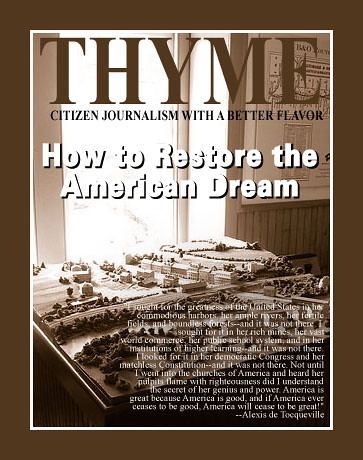
Volume IV, Issue XXV
Cover: Ellicott's Mills in miniature as created by Bob Kirchman in 1971/1972 at age 20. It was refurbished and corrected to reflect current research for the B&O Museum's 'Roads to Rails' exhibit two years ago.
Remembering our Roots
The 'other' Weekly News Magazine [click to read] presents: "The History of the American Dream." If the American Dream is merely about home ownership and material security, we're down for the count. In the late seventies the government sought to make home ownership available to all. In 2007 we got the bill for it.
But if we see the American dream as something more... those desires that drove people to our shores in the first place, we're ready for a renaissance.
The Pilgrims, the Anabaptists and Moravians were drawn to this land by the promise of freedom to worship and live without interference from hostile government interference. Indeed they preferred the risk and hardship it entailed to the relative safety of servitude.
By 1831, Alexis de Tocqueville observed an amazing young nation taking shape and wrote:
"I sought for the greatness of the United States in her commodious harbors, her ample rivers, her fertile fields, and boundless forests--and it was not there. I sought for it in her rich mines, her vast world commerce, her public school system, and in her institutions of higher learning--and it was not there. I looked for it in her democratic Congress and her matchless Constitution--and it was not there. Not until I went into the churches of America and heard her pulpits flame with righteousness did I understand the secret of her genius and power. America is great because America is good, and if America ever ceases to be good, America will cease to be great!"
Though many would seek to obfuscate this heritage, a serious study of history shows that our nation perservered and grew, often against impossible odds, as her founders labored and prayed, trusting in Divine Providence.
The Free Market Did NOT Cause the Great Depression
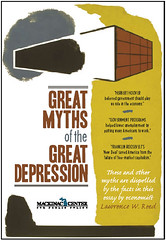
Great Myths of the Great Depression [Click to Read] by Lawrence W. Reed
"President Herbert Hoover is mistakenly presented in standard history texts as a laissez-faire president, but he signed into law so many costly and foolish bills that one of Franklin Roosevelt’s top aides later said that “practically the whole New Deal was extrapolated from programs that Hoover started.”
"Americans voted for Franlin Roosevelt in 1932, expecting him to adhere to the Democratic Party platform, which called for less government spending and regulation." -- Lawrence W. Reed
The really frightening thing about history is how it repeats itself.
Required Reading:

In light of the President's assertion that 'America is not a Christian Nation' I would like to offer Alvin Schmidt's book Under the Influence, How Christianity Changed the World. There are many legitimate arguments to be made about how Faith and Government should function together but a look at the principles that our Nation was founded upon will show a clear Judeo-Christian influence.
"If no other consideration had convinced me of the value of the Christian life, the Christlike work which the Church of all denominations in America has done during the last 35 years for the elevation of the black man would have made me a Christian." -- Booker T. Washington in 'Up from Slavery' (1901)
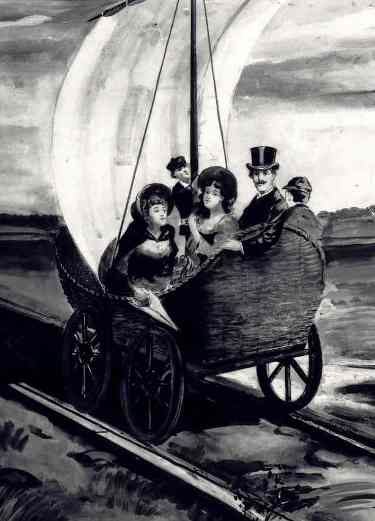
AEolus sails down the Baltimore and Ohio tracks. The B&O experimented with wind power but soon moved on to more dependable steam locomotives. [1.] From the Collections of the B&O Railroad Museum, used with permission.
The American Dream and Ellicott's Mills
The little model featured on this week's cover was built to show the extent to which Ellicott's Mills had developed by the middle of the Nineteenth century! It was founded in 1772 by John, Joseph and Andrew Ellicott, who convinced Charles Carroll [the one who signed the Declaration of Independence] to move away from single crop agriculture on his estate of Carrollton. Tobacco was the big cash crop and that was all Carroll grew in the beginning. The brothers built a flour mill and promoted a more diverse agriculture. That kept the region from experiencing the soil depletion that occured in many plantation areas.
Carroll planted wheat and other crops and the Ellicotts milled the wheat. They also partnered with Charles Carroll to build a turnpike which was later incorporated into the great National Road The Ellicotts operated a sawmill and another mill for crushing limestone. This was usd to enrich the fields. They also operated an iron rolling mill. Joseph Scott's "Geographical Description of the States of Maryland and Delaware," published in 1807, tells of the economic diversity Ellicott's Mills had achieved at this early date. "Several kinds of mechanical trades are carried on here; such as coopers, blacksmiths, tanners, shoemakers, saddlers."
In 1830 the town became the first terminus of the Baltimore and Ohio Railroad. The first rail cars were horse-drawn and a sail-powered car was even tried on the new iron road. Steam was to prevail as the motive power of choice and the legendary race between the steam engine Tom Thumb and a horse-drawn car was run at Relay, a point on the tracks between Ellicott's Mills and Baltimore. The old station, shown here with some later Nineteenth Century modifications, was built of granite blocks. Locally quarried granite was used to construct most of the buildings in the town. Today the old station is designated as a National Historic Landmark.
When the three Ellicotts migrated to the banks of the Patapsco from Bucks County, Pennsylvania, they found a 'picturesque wilderness.' By the turn of the Century they had established a thriving community. Then came railroads and romanticism. 'Castle Angelo,' [2.]on a cliff above the Patapsco River, is one great example of American Romantic Architecture. When Mr. Kirchman photographed it, it had been covered in aluminum siding! The siding was applied vertically on the turrets and was 'most unusual to behold.'
Although the Ellicotts, who hailed from Pennsylvania, were Quakers, their adopted home was predominantly Catholic. The Catholic church tower [3.] had an Italianate feeling rendered in the native stone and a few gothic doorways thrown in for good measure. The Friends' Meeting House where the Ellicotts worshipped was far simpler in construction.
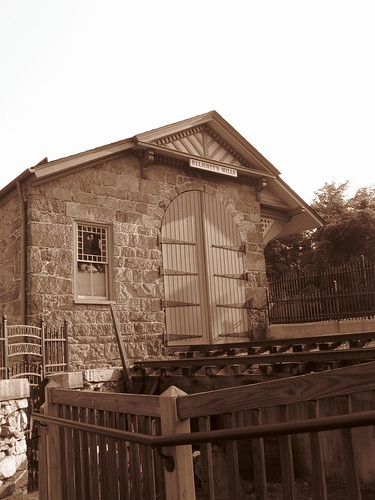
B&O Station.
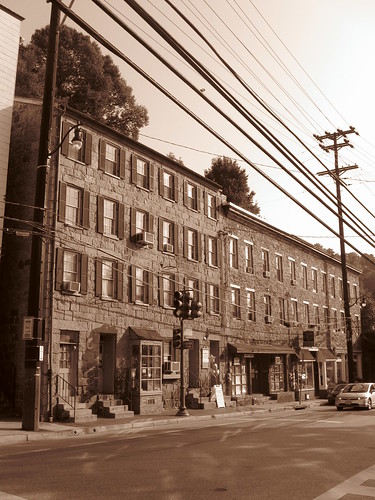
Patapsco Hotel.
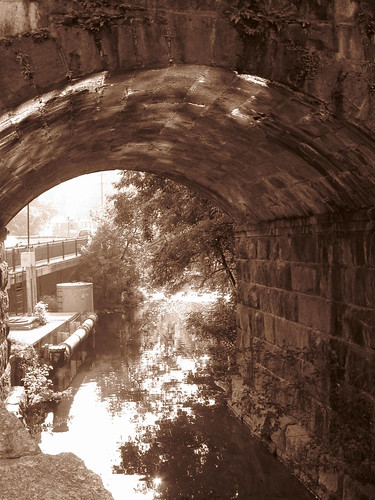
Arch of the old railroad bridge.
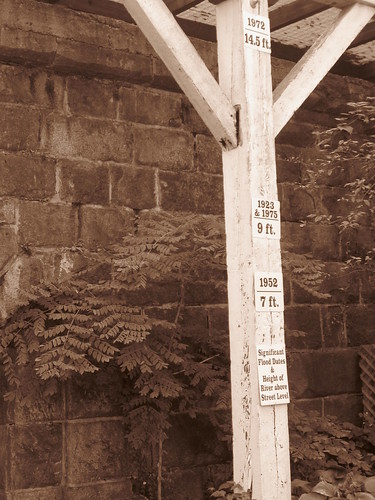
Floods of the Twentieth Century.
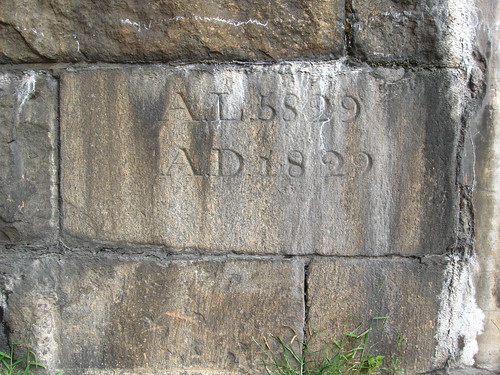
Cornerstone of the railroad bridge...
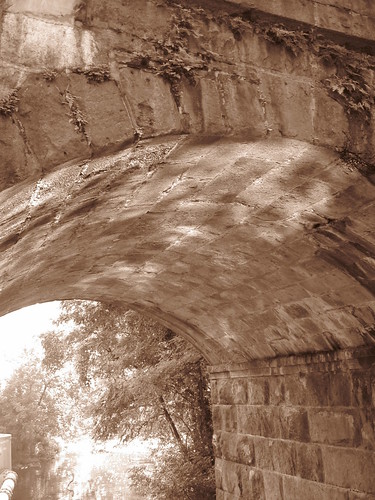
...still carrying Chessie System trains today.
The American Dream and B. Banneker
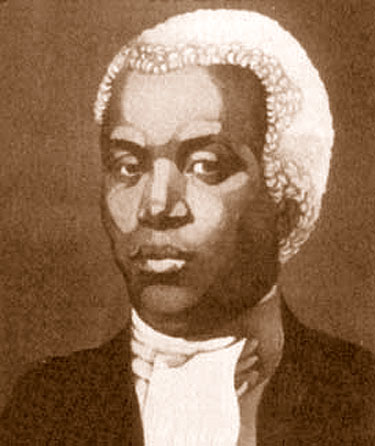
Benjamin Banneker was a renaissance man.
"You're Fired"
The story of Benjamin Banneker is forever intertwined with the planning of our nation's capital city. In 1791 Banneker was in the employment of Andrew Ellicott, who was charged with the task of laying out the monumental city plan concieved by French architect Pierre Charles de L'Enfant, who had been hired to design a capital suitable for the new republic.
L'Enfant based his design on the best traditions of Baroque landscape design and his creation resembled the hunting gardens of Louis XIV's massive palace at Versailles. L'Enfant proved to be very difficult to work with... America's first 'rock star' architect, you might say. George Washington fired him.
Here the traditional story says that L'Enfant rolled up his drawings and left the young country in a huff, taking his designs with him. Ellicott turned to Banneker, who had prepared the actual surveys, and Banneker is said to have redrawn the plans from memory!
Though many modern historians doubt that Banneker recreated the plans from memory, the man's documented accomplishments would be in keeping with those of a man capable of such a feat.
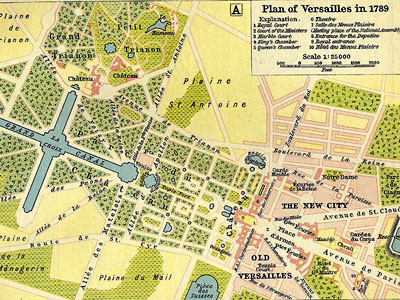
The hunting gardens of Versailles...
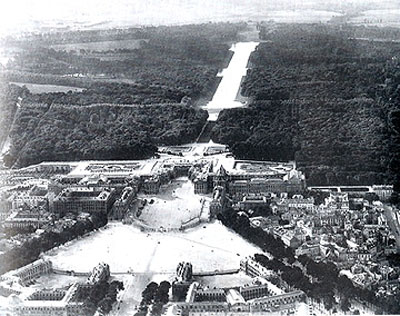
...inspiration for our nation's capital?
A simple farmer most of his life, Banneker had the good fortune to know the Quaker settlers of Ellicott's Mills in Maryland. The Society of Friends believed in providing basic education to all people and young Banneker certainly received a solid basic education.
Banneker became a student of astronomy and published an almanac. He corresponded with President Thomas Jefferson on the issue of the status of his fellow African Americans. His letter to Jefferson is well crafted, invoking reason as well as compassion. It appears that Banneker took up the craft of surveying in his fifties, looking to a time when he might be physically too old to farm.
Banneker is said to have observed the workings of a clock and then carved his own working clock mechanism from scrap wood. He published his almanac until 1802.
"Banneker lived for four years after his almanacs discontinued. He published a treatise on bees, did a mathematical study on the cycle of the seventeen-year locust, and became a pamphleteer for the anti-slavery movement. He continued scientific studies by night and walked his land by day. He also continued to keep his garden. He hosted many distinguished scientists and artists of his day, and his visitors commented on his intelligence and on his knowledge of everything of importance that was happening in the country. As always, he remained precise and reflective in his conversations with others. His last walk (with a friend) came on October 9, 1806, he complained of being ill and went home to rest on his couch. He died later that day." [4.]
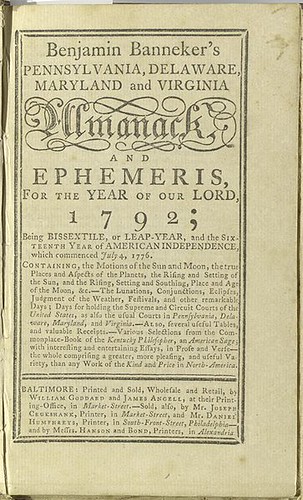
Banneker's Almanac.
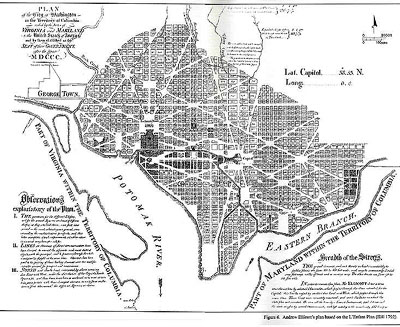
The Ellicott/Banneker map of Washington.

The city today.
THYME Interactive [click to read] brings you even more of our famous Nanny State Updates and other news you need in this crucial election year.






No comments:
Post a Comment